NCERT Solutions for Class 10 Science Chapter 9 Light Reflection and Refraction
Have you ever wondered how you can see things that are around you, or why a spoon would look bent when placed in a glass of water? Chapter 9, Class 10 Science -Light: Reflection and Refraction, assists students in studying these wonderful phenomena. The chapter describes the reflection of light on mirrors and the refraction (bending) of light through transparent substances such as glass and water, and teaches the learners to have a good idea about the reflection and refraction laws and how they apply to their daily lives.
This Story also Contains
- NCERT Solutions for Class 10 Science Chapter 9: Download Solution PDF
- NCERT Solutions for Class 10 Science Chapter 9: Intext Questions
- NCERT Class 10 Science Chapter 9: Exercise Questions
- Class 10 Science NCERT Chapter 9: Higher Order Thinking Skills (HOTS) Questions
- NCERT Solutions for Class 10 Science Chapter 9: Topics
- NCERT Solutions for Class 10 Science Light: Reflection and Refraction - Important Formulas
- Approach to Solve Questions of Class 10 Chapter 9: Light - Reflection and Refraction
- Benefits of NCERT Solutions Class 10 Chapter 9: Light
- How Can NCERT Solutions for Class 10 Science Chapter 9 Help in Exam Preparation?
- NCERT Solutions for Class 10 Science Chapter-wise
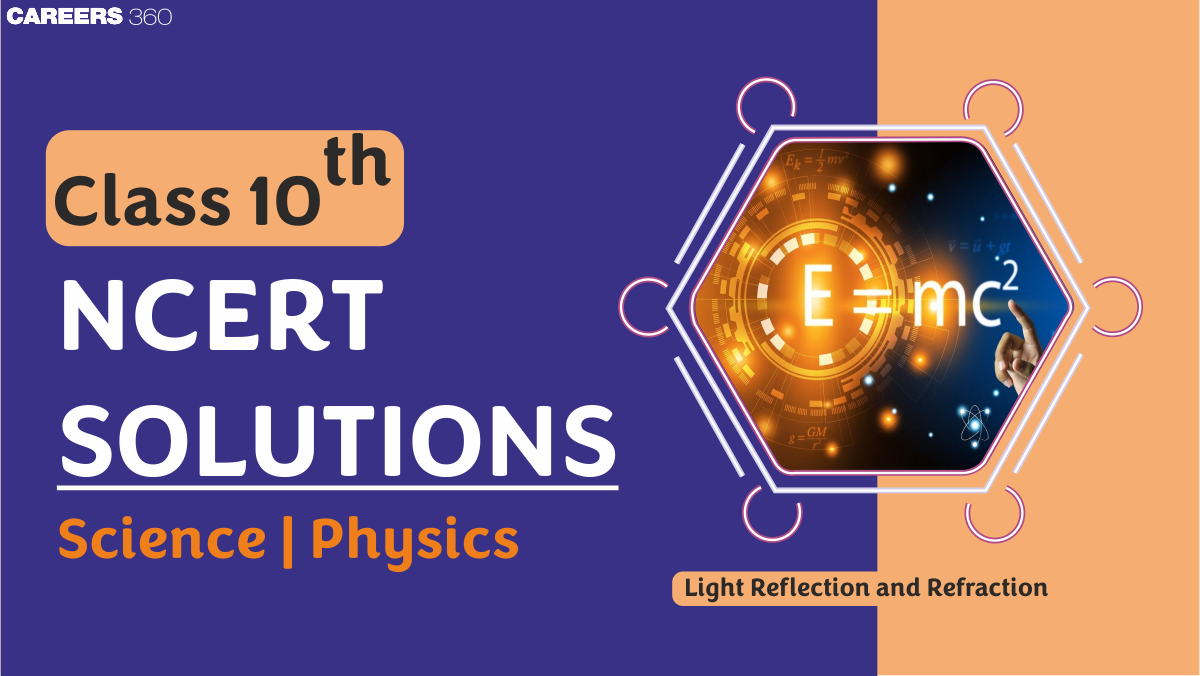
The NCERT Solutions for Class 10 Science Chapter 9 - Light Reflection and Refraction are developed by the career360 subject experts in consideration of the current CBSE syllabus (2025-26). These step-by-step NCERT Solutions for Class 10 Science Chapter 9 - Light Reflection and Refraction help students to understand all concepts in a simple manner and confidently answer in-text and exercise questions. HOTS (Higher Order Thinking Skills) questions are also in the set of solutions to reinforce the conceptual knowledge, enhance the reasoning process, and improve the preparation for exams. Using these Class 10 Light Reflection and Refraction NCERT Solutions, students would be able to learn the major concepts and get better marks in CBSE board exams.
Also Read,
NCERT Solutions for Class 10 Science Chapter 9: Download Solution PDF
Class 10 Science NCERT Solutions Chapter 9: Solution PDF gives systematic responses to every question in the textbook and makes the learning process simple and exam preparation effective. The class 10 science chapter 9 Light Reflection and Refraction question answers are also in line with the most updated CBSE, assuring students a better command of concepts and board exam practice.
NCERT Solutions for Class 10 Science Chapter 9: Intext Questions
The NCERT Solutions Class 10 Science Chapter 9: Intext questions provide a clear, step-by-step explanation to every intext question in the textbook. These class 10 science chapter 9 Light Reflection and Refraction question answers are assisting students to develop solid conceptual knowledge as well as to prepare effectively and have quality, dependable solutions to exams.
Topic 9.2.2 Representation of Images Formed by Spherical Mirrors Using Ray Diagrams
Q.1 Define the principal focus of a concave mirror.
Answer:
It is the point on the principal axis where a beam of light parallel to the principal axis, after reflection, actually meets.
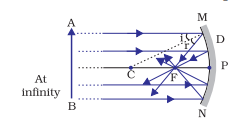
F represents the focal length
Q.2 The radius of curvature of a spherical mirror is 20 cm. What is its focal length?
Answer:
$
\text { focal length }=\frac{\text { Radius }}{2}
$
So,
$
\text { focal length }=\frac{20}{2}=10 \mathrm{~cm}
$
Hence, the Focal length of the spherical mirror is 10 cm.
Q.3 Name a mirror that can give an erect and enlarged image of an object.
Answer:
Convex mirrors usually give a virtual and erect image.
The concave mirror gives a virtual and enlarged image only when the object is between the pole and the focus.
Q.4 Why do we prefer a convex mirror as a rear-view mirror in vehicles?
Answer :
Convex mirrors are preferred as a rearview mirror in vehicles as:
i) It forms an erect (Rigidly upright or straight) image of an object, hence the object becomes easily identified.
ii) It forms a diminished image of the object, thus increasing the field of vision.
iii) An object that is far away from us is seen closer, which helps us to make early decisions while driving.
Topic 9.2.4 Mirror formula and Magnification
Q.1 Find the focal length of a convex mirror whose radius of curvature is 32 cm.
Answer:
As we know, for the convex mirror,
Radius $(R)=$ Focus $(f) \times 2$
So,
$
f=\frac{R}{2}
$
putting the given values,
$
f=\frac{30}{2}=15 \mathrm{~cm}
$
Hence Focus of the convex mirror is 15 cm.
Answer:
Here Given Magnification:
m= -3 (real image)
Given magnification $\mathrm{m}=3$
and object distance $u=10 \mathrm{~cm}$ and we know,
Magnification $\mathrm{m}=\frac{-\mathrm{v}}{\mathrm{u}}$
$
\begin{aligned}
& -\mathrm{v}=3 \times-10 \\
& \mathrm{v}=30 \mathrm{~cm}
\end{aligned}
$
Thus, the image is formed at a distance of 30 cm.
The image is 30 cm in front of the mirror.
Topic 9.3 Refraction of light
Answer:
As we know, when the light goes from a rarer medium to a denser medium, the light bends towards the normal. So when the light goes from air to water, it will bend toward the normal.
Answer:
As we know, from the definition of the refractive index that
Refractive Index :
$
\mu=\frac{c}{v}
$
Where $=$ Velocity of light in the medium and
$c=$ Speed of light in vacuum
So putting those given values, we,
$
\begin{aligned}
& 1.5=\frac{3 \times 10^8}{v} \\
& v=\frac{3 \times 10^8}{1.5} \\
& v=2 \times 10^8 \mathrm{~m} / \mathrm{s}
\end{aligned}
$
Hence, the speed of the light in the glass is $2 \times 10^8 \mathrm{~m} / \mathrm{s}$.
| Material Medium | Refractive Index | Material Medium | Refractive Index |
| Air Ice water Alcohol Kerosene Fused Quartz Turpentine oil Benzene Crown Glass | 1.0003 1.31 1.33 1.36 1.44 1.46 1.47 1.50 1.52 | Canada Balsam Rock Salt Carbon-Disulphide Dense Flint Glass Ruby Sapphire Diamond | 1.53 1.54 1.63 1.65 1.71 1.77 2.42 |
Answer :
As we know, optical density is the tendency to hold(absorb) the light. So,
more refractive index = more absorbing power = more optical density.
It can be observed from Table 10.3 that diamond and air respectively, have the highest and lowest refractive index. Therefore, diamond has the highest optical density and air has the lowest optical density.
| Material Medium | Refractive Index | Material Medium | Refractive Index |
| Air Ice water Alcohol Kerosene Fused Quartz Turpentine oil Benzene Crown Glass | 1.0003 1.31 1.33 1.36 1.44 1.46 1.47 1.50 1.52 | Canada Balsam Rock Salt Carbon-Disulphide Dense Flint Glass Ruby Sapphire Diamond | 1.53 1.54 1.63 1.65 1.71 1.77 2.42 |
Answer:
As we can see from the table:
Refractive index of kerosene = 1.44
Refractive index of terbutaline = 1.47
Refractive index of water = 1.33
We know from the definition of refractive index that the speed of light is higher in a medium with a lower refractive index.
So, the light travels fastest in water relative to kerosene and turpentine.
speed of light---> water > kerosene > turpentine
Q.5 The refractive index of diamond is 2.42. What is the meaning of this statement?
Answer:
Refractive Index shows the comparison of light speeds in two media. Light may travel from a rarer to a denser medium or from a denser to a rarer medium. When we say the refractive index of a diamond is 2.42, it means light is travelling from a rarer to a denser medium, and the speed of light in the air (vacuum) is 2.42 times the speed of light in a diamond. On the other hand, if the light travels from denser to rarer medium, that is, from diamond to air, the refractive index will be the reciprocal of 2.42.
Topic 9.3.8 Power of a Lens
Q.1 Define 1 dioptre of power of a lens.
Answer:
A lens whose focal length is 1 metre is said to have the power of 1 dioptre.
Answer:
Since the image formed by the lens is real and inverted, it is formed on the side opposite to the one where the object is placed.
Image position v = 50 cm
Let the object position be u.
Since the image formed is inverted and the size image is equal to the size of the object, magnification (m) = -1.
magnification $(m)=-1$.
$
\begin{aligned}
& m=\frac{v}{u} \\
& -1=\frac{v}{u} \\
& u=-v \\
& u=-50 \mathrm{~cm}
\end{aligned}
$
The needle is placed 50 cm in front of the lens
Using the lens formula, we have
$
\begin{aligned}
& \frac{1}{f}=\frac{1}{v}-\frac{1}{u} \\
& \frac{1}{f}=\frac{1}{50}-\frac{1}{-50} \\
& \frac{1}{f}=\frac{2}{50} \\
& f=25 \mathrm{~cm}
\end{aligned}
$
Power of the lens P is given by
$
\begin{aligned}
P & =\frac{1}{f} \\
P & =\frac{1}{25 \times 10^{-2}} \\
P & =4 D
\end{aligned}
$
The power of the lens P is 4 diopters.
Q.3 Find the power of a concave lens of focal length 2 m.
Answer:
The focal length of the lens is f = -2 m. (The focal length of a concave lens is negative)
The power of the lens P is given by
$\begin{aligned} & P=\frac{1}{f} \\ & P=\frac{1}{-2} \\ & P=-0.5 \mathrm{D}\end{aligned}$
The Power of the lens is - 0.5 Dioptre.
NCERT Class 10 Science Chapter 9: Exercise Questions
NCERT Class 10 Science Chapter 9: Exercise Questions provide detailed, well-structured answers to all the end-of-chapter exercises. These solutions help students revise key concepts, practice application-based problems, and strengthen their preparation for board exams.
Q1. Which one of the following materials cannot be used to make a lens?
(a) Water (b) Glass (c) Plastic (d) Clay
Answer:
Clay cannot be used to make a lens.
(d) is the correct answer.
(a) Between the principal focus and the centre of curvature
(b) At the centre of curvature
(c) Beyond the centre of curvature
(d) Between the pole of the mirror and its principal focus.
Answer:
The position of the object should be between the pole of the mirror and its principal focus.
(d) is the correct answer.
(a) At the principal focus of the lens
(b) At twice the focal length
(c) At infinity
(d) Between the optical centre of the lens and its principal focus.
Answer:
An object should be placed twice the focal length in front of a convex lens to get a real image of the size of the object
(b) is the correct answer.
(a) both concave.
(b) both convex.
(c) The mirror is concave and the lens is convex.
(d) The mirror is convex, but the lens is concave.
Answer:
The mirror and the lens are both concave.
(a) is the correct answer.
Q 5. No matter how far you stand from a mirror, your image appears erect. The mirror is likely to be
(a) only plane.
(b) only concave.
(c) only convex.
(d) either plane or convex.
Answer:
The mirror is likely to be either plane or convex.
(d) is the correct answer.
(a) A convex lens of focal length 50 cm.
(b) A concave lens of focal length 50 cm.
(c) A convex lens of focal length 5 cm.
(d) A concave lens of focal length 5 cm.
Answer:
I would prefer to use a convex lens of focal length 5 cm while reading small letters found in a dictionary because a convex lens gives a magnified image if the object is between the focus and radius of curvature, and the magnification will be high for a shorter focal length
(c) is the correct answer.
Answer:
$
\begin{aligned}
\frac{1}{f} & =\frac{1}{v}+\frac{1}{u} \\
v & =\frac{f u}{u-f}
\end{aligned}
$
For the image to be erect, it has to be virtual and therefore, as per convention, $v$ has to be positive
$
\begin{aligned}
& \mathrm{v}>0 \\
& \frac{f u}{u-f}>0 \\
& \mathrm{u}<0 \\
& \mathrm{f}<0 \\
& \mathrm{fu}>0 \\
& \mathrm{u}-\mathrm{f}>0 \\
& \mathrm{u}>\mathrm{f}
\end{aligned}
$
Therefore, the object must be placed between the pole and the focus of the mirror. i.e $-15 \mathrm{~cm}<\mathrm{u}<0$
The image formed would be virtual and larger than the object.
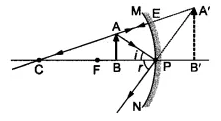
Q 8. (a) Name the type of mirror used in the following situations.
- Headlights of a car.
Support your answer with a reason.
Answer:
A concave mirror is used for the headlights of a car as they can produce parallel beams of high intensity, which can travel through large distances if the source of light is placed at the focus of the mirror.
Q 8.b) Name the type of mirror used in the following situations.
- Side/rear-view mirror of a vehicle
Support your answer with a reason.
Answer:
The convex mirror would be used as a side/rear-view mirror of a vehicle, as the image produced will be erect, virtual and diminished. A convex mirror also has a larger field of view as compared to a plane mirror of the same size.
Q 8.c) Name the type of mirror used in the following situations.
- Solar furnace.
Support your answer with a reason.
Answer:
The concave mirror would be used in a solar furnace to concentrate the incident rays from the sun on a solar panel.
Answer:
The lens would produce a complete image. Only the brightness of the image would be diminished.
Verification by experiment:
Apparatus required: a convex lens, a screen, and a candlelight
procedure:
1. Place the screen behind a lens placed vertically
2. Move the candle to obtain a clear, full-length image of a candle on the screen
3. Cover half of the lens with the black paper without disturbing the position of the lens
4. Note the observations
Observation: The size of the image is the same, but the brightness reduces
Answer:
Object distance u = -25 cm.
Focal length = 10 cm
Let image distance be v
$
\begin{aligned}
& \frac{1}{f}=\frac{1}{v}+\frac{1}{u} \\
& \frac{1}{10}=\frac{1}{v}+\frac{1}{-25} \\
& \frac{1}{v}=\frac{1}{10}+\frac{1}{25} \\
& v=16.66 \mathrm{~cm}
\end{aligned}
$
The position of the image is 16.66 cm on the other side of the lens.
Object size $\mathrm{O}=5 \mathrm{~cm}$.
Let the image size be I
Magnification is m
$
\begin{aligned}
m & =\frac{v}{u} \\
\frac{I}{O} & =\frac{16.66}{-25} \\
I & =5 \times-\frac{16.66}{25} \\
I & =-3.33 \mathrm{~cm}
\end{aligned}
$
The nature of the image is real, and its size is -3.33 cm.
The formation of the image is shown in the following ray diagram
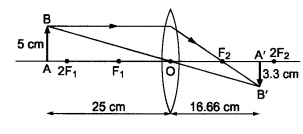
Answer:
Focal length, f = -15 cm
Image distance, v = -10 cm ( As in the case of the concave lens image is formed on the same side as the object is placed)
Let the object distance be u.
As per the lens formula
$
\begin{aligned}
& \frac{1}{f}=\frac{1}{v}-\frac{1}{u} \\
& \frac{1}{u}=\frac{1}{v}-\frac{1}{f} \\
& \frac{1}{u}=\frac{1}{-10}-\frac{1}{-25} \\
& v=-30 \mathrm{~cm}
\end{aligned}
$
The object is placed at a distance of 30 cm from the lens.
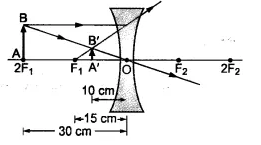
Answer:
Object distance, u = -10 cm
Focal length, f = 15 cm
Let the image distance be v
As per the mirror formula
$
\begin{aligned}
& \frac{1}{f_1}=\frac{1}{v}+\frac{1}{u} \\
& \frac{1}{15}=\frac{1}{v}+\frac{1}{-10} \\
& v=6 \mathrm{~cm} \\
& \text { Magnification }=-\frac{v}{u} \\
& =-\frac{6}{-30} \\
& =0.2
\end{aligned}
$
The image formed is virtual, erect, diminished and is formed 6 cm behind the mirror.
Q 13. The magnification produced by a plane mirror is +1. What does this mean?
Answer:
It means the image formed is virtual, erect and of the same size as the object.
Answer:
The radius of curvature, R = 30 cm
Focal length, f = R/2 = 15 cm
Object distance, u = -20 cm
Let the image distance be $v$
$
\begin{aligned}
& \frac{1}{f}=\frac{1}{v}+\frac{1}{u} \\
& \frac{1}{15}=\frac{1}{v}+\frac{1}{-20} \\
& v=8.57 \mathrm{~cm}
\end{aligned}
$
Since v is positive image is formed behind the mirror.
$
\begin{aligned}
& \text { Magnification }=-\frac{v}{u} \\
& =-\frac{8.57}{-20} \\
& =0.428
\end{aligned}
$
Object size $=5 \mathrm{~cm}$
$
\begin{aligned}
& \text { Image size }=\text { Object size } \times \text { Magnification } \\
& =5 \times 0.428 \\
& =2.14 \mathrm{~cm}
\end{aligned}
$
A virtual, erect and diminished image of size 2.14 cm would be formed 8.57 cm behind the mirror.
Answer:
Object distance, u = -27 cm
Focal length, f = -18 cm
Let the image distance be v
$
\begin{aligned}
& \frac{1}{f}=\frac{1}{v}+\frac{1}{u} \\
& \frac{1}{-18}=\frac{1}{v}+\frac{1}{-27} \\
& v=-54 \mathrm{~cm}
\end{aligned}
$
The negative sign shows the image is formed in front of the mirror and is real.
Object size $=7 \mathrm{~cm}$
$
\begin{aligned}
& \text { Image size }=\text { magnification } \times \text { Object size } \\
& =-\frac{v}{u} \times O \\
& =-\frac{-54}{-27} \times 7 \\
& =-14 \mathrm{~cm}
\end{aligned}
$
A real, inverted and magnified image of size 14 cm is formed in front of the mirror.
Q 16. Find the focal length of a lens of power – 2.0 D. What type of lens is this?
Answer:
$\begin{aligned} & f=\frac{1}{P} \\ & f=\frac{1}{-2} \\ & f=-0.5 \mathrm{~m} \\ & f=-50 \mathrm{~cm}\end{aligned}$
The lens is concave because its focal length is negative and is equal to -50 cm.
Answer:
$\begin{aligned} & f=\frac{1}{P} \\ & f=\frac{1}{1.5} \\ & f=0.6667 \mathrm{~m} \\ & f=66.67 \mathrm{~cm}\end{aligned}$
The lens is convex because its focal length is positive and therefore is converging.
Class 10 Science NCERT Chapter 9: Higher Order Thinking Skills (HOTS) Questions
Class 10 Science NCERT Chapter 9: Light HOTS questions have been created to enhance problem-solving skills and analytical ability. These questions extend the basic knowledge regarding reflection and refraction, and they will make students use their ability to solve problems associated with lenses, mirrors, and optical phenomena with the use of critical thinking.
Q1. There is a point object and a plane mirror. If a mirror is moved 10cm away from the object, then the image will move by?
Answer:
Image formation from a plane mirror -
1) Distance of object from mirror = Distance of image from the mirror.
2) The line joining a point object and its image is normal to the reflecting surface
3) The size of the image is the same as that of the object.
4) For a real object, the image is virtual, and for a virtual object, the image is real.

After moving the mirror by 10cm, the object distance = x +10 cm
Image distance from m = x+ 10cm
Movement of the image from m
= (x+20) -x = 20 cm
Hence, the answer is 20cm
Q2. A light ray is incident on a glass sphere of refractive index $\mu=\sqrt{3}$ at an angle of incidence 600 as shown, the total deviation after two refractions is:

Answer:

At point $A$ :
$
\begin{aligned}
& \text { 1. } \sin 60^{\circ}=\sqrt{3} \sin r \\
& \Rightarrow r=30^{\circ}
\end{aligned}
$
from symmetry
$
r^{\prime}=r=30^0
$
Apply Snell's law at B.
$
\begin{aligned}
& \text { 1. } \sin e=\sqrt{3} \sin r^{\prime}=\frac{\sqrt{3}}{2} \\
& \Rightarrow e=60^{\circ} \\
& \delta_1=60^{\circ}-30^0=30^0 \\
& \delta_2=e-r^1=60^{\circ}-30^{\circ}=30^{\circ} \\
& \therefore \text { total deviation }=60^{\circ}
\end{aligned}
$
Q3. An object is at a distance of 10 cm from a mirror, and an image of the object is at a distance of 30 cm from the mirror on the same side as the object. Then the nature of the mirror and its power is -
Answer:
Optical power of a mirror -
$
P=-\frac{1}{f}
$
- wherein
$f=$ focal length with a sign and is in meters, unit of power = diopter
$
\begin{aligned}
& \frac{1}{f}=\frac{1}{v}+\frac{1}{u} \\
& u=-10 \mathrm{~cm}, \mathrm{v}=-30 \mathrm{~cm} \\
& \frac{1}{f}=\frac{-1}{10}-\frac{1}{30}=-\frac{4}{30} \text { or } \mathrm{f}=-7.5 \mathrm{~cm}
\end{aligned}
$
$\therefore$ the mirror is concave
$
p=\frac{-100}{f} D=\frac{100}{7.5} D=\frac{40}{3} D
$
Q4. An object is at a distance of 10 cm from a mirror, and the image of the object is at a distance of 30 cm from the mirror on the same side as the object. The nature of the mirror and its focal length are:
Answer:
Sign Convention
1) All distances are measured from the pole.
2) Distance measured in the direction of incident rays is taken as positive.
3) Distance measured in the direction opposite to that of the incident rays is taken as negative.
4) Distance above the principal axis is positive, and below the principal axis is negative.
$u=-10 \mathrm{~cm}$
$v=-30 \mathrm{~cm}$ from sign convention
from mirror formula
$
\begin{aligned}
& \frac{1}{f}=\frac{1}{v}+\frac{1}{u}=-\frac{1}{30}-\frac{1}{10}=\frac{-4}{30} \\
& \mathrm{f}=-7.5 \mathrm{~cm}
\end{aligned}
$
Since the focal length is negative, this mirror is concave.
NCERT Solutions for Class 10 Science Chapter 9: Topics
Chapter 9: Light - Reflection and Refraction, NCERT Solutions for Class 10 under the science textbook are all inclusive in terms of the various concepts of light, namely, image formation by mirrors and lenses, sign conventions, and everyday uses of reflection and refraction. Such answers facilitate the learning process of pupils to acquire knowledge and revise the course of examinations.
9.1 Reflection of Light
9.2 Spherical Mirrors
9.2.1 Image Formation by Spherical Mirrors
9.2.2 Representation of Images Formed by Spherical Mirrors Using Ray Diagrams
9.2.3 Sign Convention for Reflection by Spherical Mirrors
9.2.4 Mirror Formula and Magnification
9.3 Refraction of Light
9.3.1 Refraction through a Rectangular Glass Slab
9.3.2 The Refractive Index
9.3.3 Refraction by Spherical Lenses
9.3.4 Image Formation by Lenses
9.3.5 Image Formation in Lenses Using Ray Diagrams
9.3.6 Sign Convention for Spherical Lenses
9.3.7 Lens Formula and Magnification
9.3.8 Power of a Lens
NCERT Solutions for Class 10 Science Light: Reflection and Refraction - Important Formulas
The chapter Light: Reflection and Refraction in Class 10 Science describes the behaviour of light as it hits the surfaces or refracts in transition as it passes through various media. In order to solve numerical questions, students should keep in mind some important formulas on mirrors, lenses, light bending and magnification. These formulae provide the basis of apprehension and excelling in exams.
-
Reflection of Light
Laws of Reflection:
Angle of incidence (i) = Angle of reflection (r)
Incident ray, reflected ray, and normal all lie in the same plane
-
Spherical Mirrors:
Mirror formula:
$
\frac{1}{f}=\frac{1}{v}+\frac{1}{u}
$
where, $f=$ focal length, $v=$ image distance, $u=$ object distance
-
Magnification (m):
$
m=\frac{h_i}{h_o}=\frac{v}{u}
$
where, $h_i=$ height of image, $h_o=$ height of object
-
Refraction of light:
Snell's law
$
n_1 \sin i=n_2 \sin r
$
where,
$n_1=$ refractive index of medium 1,
$n_2=$ refractive index of medium 2,
$i=$ angle of incidence,
$r=$ angle of refraction
- Refractive Index:
$n=\frac{\text { Speed of light in vacuum (c) }}{\text { Speed of light in medium (v) }}$
- Lenses:
Lens Formula:
$
\frac{1}{f}=\frac{1}{v}-\frac{1}{u}
$
Magnification (m):
$
m=\frac{h_i}{h_o}=\frac{v}{u}
$
Power of a Lens (P):
$
P=\frac{100}{f(\text { in } \mathrm{cm})}=\frac{1}{f(\text { in } \mathrm{m})}
$
Approach to Solve Questions of Class 10 Chapter 9: Light - Reflection and Refraction
Students should have good knowledge of fundamentals and equations in order to answer questions in Chapter 10 of the textbook of science, which is Light - Reflection and Refraction. This chapter is concerned with the use of the principles of mirrors and lenses in real life. The systematic approach is useful in answering both numerical and conceptual questions in an efficient way, as well as enhancing the ability to solve problems during exams.
- Begin with the revision of the laws of reflection and refraction, as it is the foundation of all questions in this chapter.
- Take time to master the mirror and lens formulae and sign conventions since the incorrect signs may make the whole answer different.
- Create clear ray diagrams of concave and convex mirrors and lenses to have a clear picture of the formation of an image.
- Solve numerical problems by use of the formula: 1/v+1/u=1/f to know the relationships between the focal length, the distance of objects and the distance of the images.
- Consider real-world examples such as how a microscope, camera or human eye works in order to reinforce conceptual learning.
- When answering questions based on ray diagrams, label correctly all the parts, and indicate the direction of incident and reflected or refracted rays.
- Go through solved examples in the NCERT Solutions and then attempt similar unsolved questions to test your understanding.
- Revise the difference between real and virtual images, and between converging and diverging lenses, as these are commonly asked in exams.
Benefits of NCERT Solutions Class 10 Chapter 9: Light
NCERT Solutions Class 10 Science Chapter 9: Light - Reflection and Refraction assist students to learn the basic and systematic behaviour of light in simple and organised forms. These Light Reflection and Refraction class 10 question answers elaborate major concepts such as image formation, mirror and lens formula and real-life applications. Answering these questions will enable students to become better prepared for board exams through conceptual mastery, precision, and self-confidence.
- Clear Conceptual Knowledge
The solutions describe the phenomenon of reflection and refraction in a down-to-earth, simple step-by-step form, making students get a firm grasp of the concepts of optics. - Includes All Types of Questions
It consists of in-text exercises and other questions, so that the students have practice on all types of problems covered in exams. - Step-by-Step Numerical Solutions
Formulas and sign conventions are appropriately applied in solving all numerical problems and decrease the number of calculation errors, thus increasing confidence. - Useful in preparation for exams
The NCERT questions are consistent with the CBSE exam scheme, hence, are incredibly helpful when it comes to preparing and reviewing during board exams. - Higher-Order Thinking Supports
The introduction of HOTS (Higher Order Thinking Skills) questions will enable students to use existing concepts in real-life and challenging issues.
How Can NCERT Solutions for Class 10 Science Chapter 9 Help in Exam Preparation?
Light Reflection and Refraction class 10 question answers will assist the students to perform very well in exams by explaining in simple terms such concepts as formation of the images in the mirror and lens, drawing ray diagrams and solving numerical examples involving the mirror formula and the power of a lens. These class 10 science Light Reflection and Refraction question answers simplify the process of learning the difference between reflection and refraction, and the most frequent errors to avoid, so that students can correctly answer questions and be sure of their correct answers. These step-by-step answers are good to practice on because the speed, accuracy and writing of answers are all enhanced, which is necessary to score a good mark in board exams.
NCERT Solutions for Class 10 Science Chapter-wise
NCERT Textbook Solutions of Class 10 Science consists of answers of all chapters in step-by-step detail, helping students perfect their concepts in Physics, Chemistry, and Biology. These chapter-wise links facilitate access to the solutions within a short time and prepare satisfactorily against CBSE board tests and competitive exams too.
Frequently Asked Questions (FAQs)
For every numerical problem related to mirrors, lenses, and optical calculations in Chapter 9, NCERT Solutions offers detailed solutions. These solutions divide each numerical problem into several steps: identifying given values, selecting suitable formulas, replacing values, and calculating final answers with proper units. Students gain confidence in their ability to solve similar problems on their own by mastering optical calculations with the aid of these thorough solutions.
To solve ray diagram questions, identify the type of mirror/lens, follow the standard rules for drawing rays, locate the image where rays intersect, and determine its nature (real/virtual, magnified/diminished). Practice different cases for better understanding.
The Light Reflection and Refraction Class 10 questions and answer sets include in-text, back exercise, and extra questions like HOTS and conceptual problems to prepare students for board exams.
NCERT Class 10 Science Chapter 9 Light Reflection and Refraction solutions are very helpful as they cover all textbook questions, provide clear explanations, and are aligned with the latest CBSE syllabus.
Some Light Reflection and Refraction Class 10 important questions include numerical problems on mirror formulas, refraction laws, and conceptual questions based on ray diagrams and real-life examples.
Reflection Applications: Used in vehicle mirrors, periscopes, telescopes, and makeup mirrors.
Refraction Applications: Found in eyeglasses, cameras, optical fibers, prisms, and mirages.
Centre of Curvature, Principal Axis, Principal Focus, Focal Length, Images Formed by Spherical Mirrors, Mirror formula & Magnification, Refractive index, Refraction & Laws of refraction, Lens Formula & Magnification, Power of a lens.
Popular Questions
Courses After 12th
Applications for Admissions are open.
As per latest syllabus. Physics formulas, equations, & laws of class 11 & 12th chapters
JEE Main Important Chemistry formulas
Get nowAs per latest syllabus. Chemistry formulas, equations, & laws of class 11 & 12th chapters
JEE Main high scoring chapters and topics
Get nowAs per latest 2024 syllabus. Study 40% syllabus and score upto 100% marks in JEE
JEE Main Important Mathematics Formulas
Get nowAs per latest syllabus. Maths formulas, equations, & theorems of class 11 & 12th chapters
